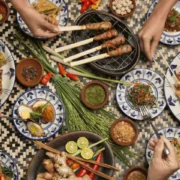
Indonesian Food Guide: Best Dishes, Street Food & Where to Eat
Indonesia, an archipelago of over 17,000 islands, is home to one of the most diverse and flavorful cuisines in the world. With its vast geographical expanse and rich cultural heritage, Indonesian food offers a unique blend of indigenous traditions, foreign influences, and locally sourced ingredients. Every region in Indonesia—from Sumatra to Papua—has developed its own culinary identity, resulting in an incredibly rich and varied food culture that reflects the nation’s history, trade routes, and natural resources.
The deep culinary diversity of Indonesia can be attributed to centuries of interactions with traders, explorers, and settlers from different parts of the world. Spices such as nutmeg, cloves, and pepper, once highly sought after by European merchants, have played a crucial role in shaping the flavors of Indonesian cuisine. The influences of Chinese, Indian, Middle Eastern, and Dutch cooking techniques have further enriched local dishes, giving rise to a fusion of bold flavors, aromatic spices, and distinctive textures.
From the bustling street food markets in Jakarta to the time-honored royal feasts of Yogyakarta, Indonesian food is as vibrant as the culture itself. Every meal is a celebration of flavors—whether it’s the fiery heat of sambal, the deep umami of slow-cooked rendang, or the comforting sweetness of coconut-infused desserts. More than just sustenance, food in Indonesia represents hospitality, tradition, and a shared love for bold, unforgettable tastes. Whether you’re indulging in a simple bowl of meatballs from a roadside vendor or savoring a lavish rijsttafel spread, Indonesia’s culinary scene guarantees an immersive and delightful experience for food lovers worldwide.
Table of Contents
ToggleEssential Ingredients in Indonesian Cooking
Indonesian food is known for its bold and complex flavors, achieved through a carefully selected combination of spices, herbs, and staple ingredients. These elements not only enhance the taste but also contribute to the depth and richness of Indonesian cuisine. Understanding these essential ingredients will give you a deeper appreciation of how traditional Indonesian dishes are crafted.
1. The Aromatic Foundations: Spices and Herbs
Spices and herbs are the backbone of Indonesian food, creating its signature fragrant spices and bold flavors. Many Indonesian dishes begin with a spice paste called bumbu, which consists of blended or pounded aromatic ingredients. Here are some of the most commonly used spices and herbs:
-
Galangal (Lengkuas)
A relative of ginger, galangal has a peppery and citrusy aroma that adds depth to dishes like rendang and soto.
-
Turmeric (Kunyit)
Known for its earthy and slightly bitter taste, turmeric gives Indonesian curries and yellow rice their distinct golden color.
-
Lemongrass (Serai)
Used in soups and curries, lemongrass infuses dishes with a refreshing citrusy scent.
-
Coriander (Ketumbar)
Ground coriander seeds provide a mild, nutty flavor that balances out the stronger spices in many Indonesian marinades.
-
Candlenut (Kemiri)
Often used as a thickening agent, candlenuts add a creamy texture and slightly nutty taste to sauces and spice pastes.
2. The Fiery and Flavorful Sambal
No discussion of Indonesian food is complete without sambal. This fiery chili paste is a staple in almost every Indonesian meal, enhancing dishes with heat and umami. There are many variations of sambal, but the most popular ones include:
-
Sambal Terasi
A blend of chili, garlic, lime, and shrimp paste for a deep, savory taste.
-
Sambal Matah
A Balinese raw sambal made with chopped chilies, shallots, lemongrass, and lime leaves, offering a fresh and zesty kick.
-
Sambal Hijau
A milder green chili sambal is often served with Padang dishes, known for its tangy and slightly smoky flavor.
3. Coconut Milk: The Creamy Base of Many Dishes
Coconut milk (santan) is a key ingredient in many Indonesian dishes, adding richness and a velvety texture. Whether used in savory stews like gulai and opor ayam or in desserts like kolak, coconut milk brings a smooth and slightly sweet flavor that balances out spicy and aromatic elements.
4. The Staple Flavors: Sweet, Salty, and Umami
Indonesian cuisine is all about balance, and these key ingredients help achieve a harmonious blend of flavors:
-
Palm Sugar (Gula Aren)
This unrefined sugar has a deep caramel-like sweetness that enhances sauces and desserts.
-
Sweet Soy Sauce (Kecap Manis)
A thick, sweetened soy sauce that gives dishes like nasi goreng and satay their signature sweet-savory glaze.
-
Shrimp Paste (Terasi)
A fermented seafood paste that adds a bold umami kick to sambal, curries, and stir-fries.
-
Tamarind (Asam Jawa)
Used in soups and dressings, tamarind provides a tangy and slightly sour note that balances rich flavors.
5. Rice and Noodles: The Heart of Every Meal
Rice and noodles are the foundation of most Indonesian meals, acting as a neutral base to soak up the complex and layered flavors of the dishes:
-
Rice (Nasi)
Served in every meal, whether as steamed white rice (nasi putih), coconut-infused rice (nasi uduk), or crispy fried rice (nasi goreng).
-
Rice Noodles (Bihun, Kwetiau, Mie)
Used in stir-fries, soups, and street food snacks, offering a chewy and satisfying texture.
The beauty of Indonesian food lies in its use of fragrant spices, fresh herbs, and rich coconut-based sauces that create an unforgettable culinary experience. Whether you’re savoring the heat of sambal, the creaminess of coconut milk, or the umami depth of shrimp paste, every bite of Indonesian cuisine tells a story of tradition and flavor.
Must-Try Indonesian Dishes: A Culinary Adventure
Indonesian food is a vibrant mix of flavors, textures, and aromas, reflecting the country’s rich cultural diversity. From sizzling street food to royal-inspired delicacies, Indonesia offers a wide range of must-try dishes that capture the essence of its culinary heritage. Whether you’re a first-time visitor or a food enthusiast eager to explore, these iconic dishes should be on your list.
1. Nasi Goreng – Indonesia’s Signature Fried Rice
A true representation of Indonesian food, nasi goreng is a street food classic that stands out for its unique blend of flavors. Unlike regular fried rice, nasi goreng is enhanced with kecap manis (sweet soy sauce), giving it a savory and slightly caramelized taste. Often served with a fried egg, crispy shallots, and prawn crackers, this dish is a staple found in restaurants and roadside stalls across Indonesia.
2. Rendang – The Ultimate Flavorful Curry
Recognized as one of the most delicious dishes in the world, rendang is a slow-cooked beef dish originating from Padang, Sumatra. The meat is braised in coconut milk and a rich blend of fragrant spices like lemongrass, galangal, and turmeric, resulting in an intensely savory delight with a melt-in-your-mouth texture. Rendang is traditionally served during special occasions and ceremonies, but it is now widely enjoyed by locals and travelers alike.
3. Satay (Sate) – The Perfect Grilled Skewers
Satay, or sate ayam, is one of the most beloved dishes in Indonesian food culture. These skewered and grilled meats—often chicken, beef, or lamb—are marinated in a blend of bold flavors before being charred over an open flame. Served with a thick and creamy peanut sauce, satay is a signature dish that showcases Indonesia’s mastery of grilling techniques.
4. Gado-Gado – Indonesia’s Unique Salad
For a healthier yet equally flavorful option, gado-gado is a must-try. This traditional Indonesian salad consists of blanched vegetables, tofu, tempeh, and hard-boiled eggs, all smothered in a rich peanut dressing. The combination of textures and fresh herbs makes it a refreshing and satisfying meal.
5. Bakso – Indonesia’s Favorite Meatball Soup
A comforting bowl of bakso is a common sight in Indonesian street food stalls. This savory delight consists of beef or chicken meatballs served in a flavorful broth with noodles, fried shallots, and celery. Whether enjoyed as a quick snack or a hearty meal, bakso is a favorite among locals and travelers alike.
6. Soto – Indonesia’s Flavorful Soup
Soto is a traditional Indonesian soup made with a fragrant broth infused with aromatic spices. There are many regional variations, but the most famous include soto ayam (chicken soup with turmeric) and soto Betawi (rich coconut milk-based beef soup). The combination of tropical ingredients and warm spices makes soto a comforting dish enjoyed across the country.
7. Nasi Padang – A Feast of Indonesian Delicacies
Originating from West Sumatra, Nasi Padang is more than just a dish—it’s an experience. A variety of small plates featuring Indonesian food favorites such as rendang, sambal, and fried fish are served with steamed rice. Each bite is packed with rich flavors that define Padang cuisine, making it a must-try for food lovers.
Indonesian Street Food: A Taste of Local Life
Indonesian food is renowned for its diverse flavors, and nowhere is this more evident than in the country’s vibrant street food scene. From bustling night markets to roadside vendors, street food is an essential part of daily life in Indonesia. These affordable yet delicious local delicacies offer a true taste of the country’s culinary culture, blending traditional flavors with modern twists. Whether you’re exploring Jakarta, Bandung, or Bali, street food is a must-try experience for every food enthusiast.
1. Martabak – The Ultimate Sweet and Savory Indulgence
One of the most popular street foods in Indonesia, martabak comes in two delicious varieties: sweet (martabak manis) and savory (martabak telur). The sweet version is a thick, pancake-like treat filled with chocolate, cheese, peanuts, or condensed milk, making it a sweet indulgence that satisfies every dessert lover. Meanwhile, the savory martabak is a crispy, stuffed omelet filled with seasoned minced meat and onions, creating a savory treat perfect for sharing.
2. Tahu Goreng – Crispy Bites of Fried Tofu
A staple in Indonesian food, tahu goreng (fried tofu) is a simple yet incredibly satisfying snack. This golden, crunchy delight is often served with spicy sambal or sweet soy sauce, making it an irresistible crispy bite that pairs well with rice or eaten on its own. You’ll find tahu goreng being freshly fried at roadside stalls, where the sizzling sound from the sizzling griddle draws hungry passersby.
3. Siomay – Indonesia’s Answer to Dim Sum
Inspired by Chinese dumplings, siomay is an Indonesian take on steamed fish dumplings. Typically served with a generous amount of peanut sauce, siomay is often accompanied by boiled eggs, potatoes, and cabbage, making it a wholesome meal. This savory treat is commonly found at street food carts, where vendors steam the dumplings fresh for each customer.
4. Sate Padang – A Spicy Twist on Traditional Satay
Unlike regular satay, Sate Padang is a specialty from West Sumatra, known for its thick, spicy sauce made from aromatic spices and beef broth. The skewered meat—often beef or offal—is grilled to perfection before being drenched in the flavorful sauce. Served with rice cakes and crispy shallots, this dish is a must-try for those looking to explore the bolder side of Indonesian food.
5. Gorengan – Indonesia’s Favorite Deep-Fried Snacks
Gorengan refers to a variety of deep-fried snacks, including pisang goreng (fried banana), tempe goreng (fried tempeh), and bakwan (vegetable fritters). These crispy bites are popular street-side snacks, often sold in paper bags for an easy, on-the-go treat. Gorengan is best enjoyed fresh and hot, with a side of chili for an extra kick.
6. Kerak Telor – A Traditional Betawi Omelet
Originating from Jakarta’s Betawi culture, kerak telor is a unique omelet made with glutinous rice, duck eggs, dried shrimp, and coconut. Cooked over a charcoal stove, it develops a slightly crispy texture with a rich, savory flavor. Often found at cultural festivals and night markets, kerak telor is a true local delicacy that represents Indonesia’s deep culinary traditions.
7. Es Campur – A Refreshing Street Dessert
After indulging in the many savory treats of Indonesian food, cool off with a bowl of es campur. This refreshing dessert consists of shaved ice, coconut milk, sweet syrup, grass jelly, and various tropical fruits. Perfect for Indonesia’s hot weather, es campur is a go-to dessert for locals and tourists alike.
Where to Try Authentic Indonesian Food (Restaurants & Local Recommendations)
Indonesia is home to a rich and diverse culinary scene, offering everything from humble warung makan to high-end fine-dining Indonesian restaurants. Whether you’re looking for a casual street food experience or an elegant meal featuring heritage recipes, there are plenty of places to enjoy Indonesian food at its finest. Here’s a guide to the best spots to savor authentic flavors across Indonesia.
1. Warungs: The Heart of Traditional Indonesian Cuisine
If you want a true taste of Indonesian food, visiting a warung makan (small local eatery) is a must. These family-owned establishments serve home-cooked meals using heritage recipes passed down through generations.
Recommended Warungs:
- Warung Bu Oka (Bali) – Famous for its succulent babi guling (Balinese roasted pork).
- Warung Tugu (Yogyakarta) – Specializing in gudeg, a slow-cooked jackfruit dish.
- Warung Nasi Ampera (Bandung) – Offers a variety of Sundanese specialties with authentic flavors.
2. Street Food Stalls: Savor Local Delights
For those who love discovering hidden culinary gems, Indonesia’s vibrant street food scene is the perfect place to explore. You’ll find everything from sizzling satay skewers to rich and hearty sop buntut (oxtail soup).
Where to Find the Best Street Food:
- Jalan Malioboro (Yogyakarta) – A paradise for street food lovers, offering everything from bakpia to nasi kucing.
- Pasar Baru (Jakarta) – Home to legendary vendors selling kerak telor, a classic Betawi omelet.
- Night Markets in Bali – Sample sate lilit, grilled fish, and fresh seafood prepared in traditional Balinese style.
3. Fine Dining Indonesian Restaurants: Elevated Traditional Cuisine
For a refined take on Indonesian food, visit fine-dining Indonesian restaurants that blend tradition with innovation. These establishments craft exquisite dishes using premium ingredients while maintaining authentic flavors.
Top Fine Dining Restaurants:
- Tugu Kunstkring Paleis (Jakarta) – A luxurious restaurant serving royal Javanese cuisine.
- Mozaic (Bali) – A Michelin-star-style restaurant offering Indonesian-inspired gourmet dishes.
- Kaum (Jakarta & Bali) – A contemporary eatery showcasing indigenous Indonesian culinary traditions.
4. Traditional Markets: A Culinary Adventure
Visiting traditional markets is a great way to experience authentic flavors while shopping for fresh ingredients and ready-to-eat delights. Many markets feature vendors who prepare meals on the spot, allowing visitors to enjoy local specialties in a lively setting.
Best Markets for Indonesian Food:
- Pasar Santa (Jakarta) – A trendy market with a mix of modern and traditional street food.
- Pasar Ubud (Bali) – Famous for Balinese snacks, fresh produce, and traditional spices.
- Pasar Beringharjo (Yogyakarta) – Offers a variety of Javanese street food and herbal drinks.
5. Hidden Culinary Gems: Off-the-Beaten-Path Eateries
Beyond the popular tourist spots, there are countless hidden culinary gems where locals go for the best Indonesian food. These restaurants and cafes are known for their rich history, family-owned eatery charm, and unwavering dedication to traditional cooking methods.
Underrated Indonesian Restaurants Worth Visiting:
- Warung Mak Beng (Bali) – Known for its legendary fish soup and fried fish set meal.
- RM Sederhana (Various Locations) – A must-visit for Padang cuisine lovers, famous for rendang.
- Gudeg Pawon (Yogyakarta) – An old-school eatery where customers line up for freshly cooked gudeg straight from the kitchen.
Explore Jakarta’s Culinary & Cultural Delights with the Jakarta City Tour
After discovering the rich and diverse world of Indonesian food, why not take your exploration further with an immersive cultural journey? Jakarta, the bustling capital of Indonesia, is not only home to incredible street food and traditional dishes but also boasts a fascinating blend of history, heritage, and modern attractions. With the Jakarta City Tour, you can experience the city’s vibrant markets, historical landmarks, and local dining spots that serve the most authentic flavors of Indonesia.
This guided tour by Ekaputra Tour takes you to must-visit locations such as the iconic Monas, the historic Old Batavia, and lively food districts where you can sample Jakarta’s culinary treasures firsthand. Whether you’re a food enthusiast or a curious traveler, this tour provides the perfect opportunity to deepen your appreciation of Indonesian culture beyond its cuisine. Book your Jakarta City Tour today and let your taste buds and curiosity lead the way!


